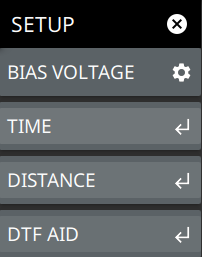 | BIAS VOLTAGE The SOURCE button offers several triggering options depending on which view mode the instrument is set. TIME Opens TIME Menu. DISTANCE Opens DISTANCE Menu. DTF AID Opens DTF AID Menu. |
 | BIAS VOLTAGE The SOURCE button offers several triggering options depending on which view mode the instrument is set. TIME Opens TIME Menu. DISTANCE Opens DISTANCE Menu. DTF AID Opens DTF AID Menu. |
 | START DISTANCE Enters a start distance value for the measurement. The start distance must be shorter than the stop distance. STOP DISTANCE Enters the stop distance for the measurement. The maximum stop distance is 1500 m. Note that the maximum distance measurement (from start to stop) is dependent on frequency span and the number of sweep points. UNITS Selects distance units of meters or feet. START FREQUENCY Sets the start frequency of the sweep range. Selecting the plus (+) or minus (–) control moves the start frequency in discrete steps. STOP FREQUENCY Sets the stop frequency of the sweep range. Selecting the plus (+) or minus (–) control moves the start frequency in discrete steps. DATA POINTS Sets the number of display point currently measured by the instrument. Note that increasing the number of display points can improve the resolution of measurements in addition to increase in sweep time. CABLE LIST Opens a list of available cable specifications. When a cable is selected from this list, propagation velocity and cable loss are automatically set by the instrument. If the preselected values for propagation velocity or cable loss are changed, the analyzer will use “NONE” as the cable type. CABLE LOSS Manually enters a cable loss value. PROP VEL Manually enters a propagation velocity value. WINDOWING Selects the windowing for the measurement: • Rectangular: Rectangular windowing shows the highest side lobe levels (worst) and the greatest main lobe resolution (best). • Nominal Side Lobe: Nominal side lobe windowing shows lesser side lobe levels than rectangular windowing (good) but lower main lobe resolution (very good). • Low Side Lobe: Low side lobe windowing shows less side lobe levels than nominal windowing (very good) but lower main lobe resolution (good). • Minimum Side Lobe: Minimum side lobe windowing shows the lowest side lobe levels (best) but the least main lobe resolution (worst). • Kaiser-Bessel: Kaiser-Bessel windowing shows lower side lobes, but a wider main lobe width for larger Beta values. • Dolph-Chebyshev: Dolph-Chebyshev windowing shows the parameterized side lobe level and a wider main lobe width. PROCESSING Selects either low pass or band pass processing method. |